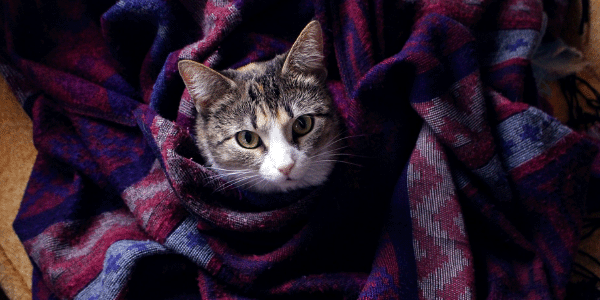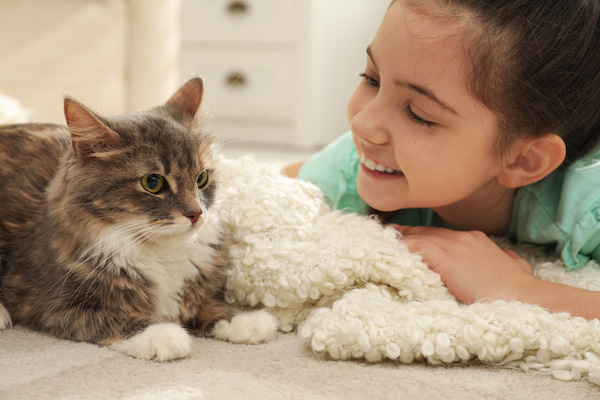- en
Your cat just puked. The litter box is a mess. Now what?
This pet information prescription will help you know what to do, how to make your cat more comfortable, and how to prevent this from happening in the future.
Never give over-the-counter (OTC) human medications without consulting your veterinarian first. This includes such common “antidiarrheals” as Imodium®, Kaopectate®, and Pepto Bismol®. For one, they can be toxic to your pets, but also because, depending on the cause of your pet’s diarrhea, these medications may do more harm than good.
Quick Links

Very young and senior cats need to be seen by a veterinarian right away if they have more than two instances of diarrhea.
Dehydration, electrolyte, and acid/base imbalances, among other complications, can set in quickly.
Our mission is to help save dogs' and cats’ lives through our educational content. To support our efforts, this page may contain affiliate links. We earn a commission for qualifying purchases – at no cost to you.
All cats, even healthy cats, will throw up on occasion. If it’s more than once a week, however, your cat has a problem. If your cat is also having diarrhea, there is definitely a problem. These are some of the reasons cats vomit or have diarrhea:
What's a Hairball and When a Hairball Isn't a Hairball
14 Human Foods You Shouldn't Give Your Cat
This depends on the cause. All cats will get a hairball or two at some point, but long-haired cats or those with skin or fur conditions who over-groom will get them more often.
If your cat has access to the outdoors or is in their young and playful stages, they’re more likely to ingest something they shouldn’t or pick up intestinal parasites like roundworms and tapeworms.
For cats with certain diseases or food allergies, causes are still being identified but can be aggravated by particular diets or table scraps.
Follow your veterinarian’s instructions on giving medication (if prescribed) and, equally importantly, diet. Some cats will be given an injection of an anti-nausea or anti-vomiting medication in the veterinarian’s office, and your veterinarian may also send additional medications to give at home.
Your cat may also need fluids, given via a needle under their skin called subcutaneous fluids, to prevent them from becoming dehydrated.
Your veterinarian will also give you a recommendation on what to feed your cat at home or send home a special, easily digested diet for your cat to eat while they are recovering. A probiotic may also be given to help your cat’s stomach and intestines return to normal sooner. You can try a probiotic like Purina’s FortiFlora® or Nutramax’s Proviable®.
It’s important to feed them this bland diet and prevent them from accessing other food or treats.
Example of a bland diet:
Cats may eat this bland diet, but they tend to prefer the special bland diets your veterinarian sells in cans.

The best thing you can do is to use the medication and diet your veterinarian prescribed and keep a close eye on your cat’s eating, drinking, and litter box usage. Because they don’t feel well, you may want to confine your cat to a smaller area of your home where their food, water, and litter box are all close by.
Because smell encourages cats to eat, you may need to warm up their food, which releases the smell (just make sure it's not too hot), or try a few varieties your veterinarian recommended in order to get them to eat. Be sure to clean their food and water bowls to remove any lingering smells, debris, or bacteria. If they can go in the dishwasher, that is the best to disinfect them, but soap and water will do!
Litter boxes should be scooped daily, and you may consider adding an extra box nearby to prevent any accidents or your cat having to step in diarrhea if they have to go before you’re able to clean it up.
Your cat should stop vomiting within 24–36 hours after seeing the veterinarian. They should also show more interest in eating and drinking, and likely will be more active.
Diarrhea may take a little longer to get better, but you should start seeing improvement in the stool consistency within 2–3 days and your cat should be fully back to normal within one week.

If your cat continues to vomit 2–3 days after seeing the vet, especially more than once a day, or if you see blood in the vomit or diarrhea at any point, bring your cat back to the veterinarian. In addition to digging deeper into the cause of your cat’s illness, they may need to give your cat fluids to prevent dehydration and change up the medication and diet your cat is receiving. If you can, bring a poop sample with you to the veterinarian in case additional testing is needed.

There are many causes of vomiting and diarrhea, each with a different recommended prevention strategy.
For cats who are sick from intestinal parasites, consider making them an indoor-only cat and use regular parasite prevention products. Be sure to have their poop checked at least annually to prevent an infestation of these worms.
For cats who are vomiting from hairballs, increase their brushings so that they don’t ingest as much hair. Your veterinarian may also recommend a long-term hairball prevention diet or supplement like Laxatone to help your cat pass hairballs easier in their stool.
For cats who are having vomiting and diarrhea from inflammatory bowel disease or a food allergy, feed them only the food your veterinarian recommends, and avoid any treats or table scraps.
And of course, if your cat is having vomiting and diarrhea because they got into something they shouldn’t, remove this from their environment, keep them indoors and make sure they have plenty of cat-safe play toys!
The Pet InfoRx® is made possible, in part, through our partnership with AlignCare®.


© Preventive Vet. All rights reserved. PreventiveVet.com
